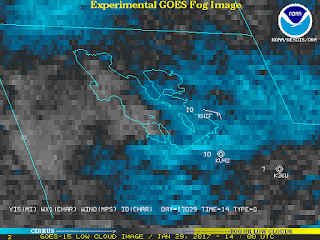UWFPS 2017 daily cold-air pool
forecast valid Tuesday 01/31/2017 8:00 MST (8:00 am local time)
Summary: The most significant cold-air pool episode of the 2016-2017 winter continues, with a multi-day period with PM2.5 above the National Ambient Air Quality Standard in Utah, Salt Lake, and Cache Valleys expected through Friday. A weakening and dilution of pollution within the cold-air pool is likely Saturday as a storm system crosses the area, however complete mix-out remains uncertain as only minor changes between model solutions will be the difference between complete or partial mix-out. Weaker valley inversions could potentially continue until another possible storm Monday or Tues 6 or 7 February.
Current
weather synopsis and short-term forecast for Tuesday 30 January:
A shallow and pronounced temperature inversion contines on day 5 (Tuesday) of the cold-air pool. A stratus layer re-formed Monday night at the bottom of the strong capping inversion very similar to Sunday night.
A shallow and pronounced temperature inversion contines on day 5 (Tuesday) of the cold-air pool. A stratus layer re-formed Monday night at the bottom of the strong capping inversion very similar to Sunday night.
 |
| 1200 UTC 31 January KSLC Sounding |
The low clouds appear to be very similar to those observed yesterday. Thus, persistence forcast with the cloud deck lifting by mid-morning is the most likely scenario. However, very minor changes in temperature and moisture structure can lead to the fog not lifting, so it is a 'waiting game' in terms of aircraft operations.
Visibility/ceiling/clouds: Cloudy/foggy in the morning with visibility in 1-3 mile range and ceilings in the 500-1000 ft agl range. transitioning to partly cloudy and hazy in the afternoon. Ceilings rising to around 2000 feet and visibility in the 2-4 mile range.
Winds: Southerly 5-10 kts below inversion height in the morning in the Salt Lake and Utah Valley. Turning northwesterly 5 kts in the afternoon. light and variable in Cache.
Wednesday 1 February:
Persistence forecast (similar evolution to Sunday night into Monday) used at this time. However, this forecast will be updated this afternoon/evening. It is possible that the nocturnal cloud deck dissipates with the arrival of mid-level moisture either Tuesday night or Wednesday night.
Visibility/ceiling/clouds: Coudy in the morning transitioning to mostly cloudy in the afternoon. Ceilings near 700 feet with 1 mile visibility rising to around 2000 feet and visibility in the 2-4 mile range. Patchy dense fog with 0.25 mile visibility before 10 am in Cache and Utah Valley.Winds will also begin to increase and be channelled at times into the Salt Lake Valley from the south through the Jordan Narrows gap afternoon on Wednesday.
Persistence forecast (similar evolution to Sunday night into Monday) used at this time. However, this forecast will be updated this afternoon/evening. It is possible that the nocturnal cloud deck dissipates with the arrival of mid-level moisture either Tuesday night or Wednesday night.
Visibility/ceiling/clouds: Coudy in the morning transitioning to mostly cloudy in the afternoon. Ceilings near 700 feet with 1 mile visibility rising to around 2000 feet and visibility in the 2-4 mile range. Patchy dense fog with 0.25 mile visibility before 10 am in Cache and Utah Valley.Winds will also begin to increase and be channelled at times into the Salt Lake Valley from the south through the Jordan Narrows gap afternoon on Wednesday.
Winds: Southerly 10-15 kts below inversion height in the Salt Lake and Utah Valley. light and variable in Cache.
Thursday 2 February- Tuesday 7
February:
The cold-air pool will continue with pollution levels
continuing to climb through at least Thursday, and likely into Friday.
Key events to watcch during this peruod:
Key events to watcch during this peruod:
- Rain and snow and potential mix-out or partial mix-out Friday night into Saturday morning
- Second storm system Monday night-Tues morning that will potentially complete the mix-out if first one does not do the job.
Precipitation is likely Friday into Saturday. The unknown is whether the mixing and cold air with the system are sufficient to overturn the toxic soup that will be in the Utah basins. Details are uncertain at this time as models do not agree yet on either the strength of the remaining temperature inversion or if the storm system will be cold enough to easily scour out pollution from the low elevations of the Great Salt Lake or Cache Valley. A brief return to high pressure on Sunday will be followed by potentially another storm Monday into Tuesday.





